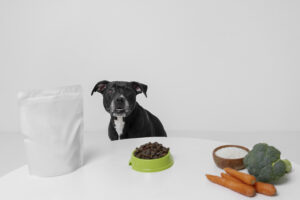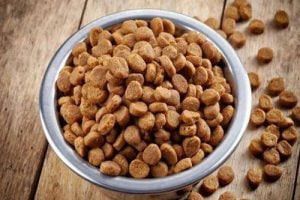To feel confident that your dog is benefiting from its nutritious lifestyle, look for these external symptoms:
1. Glossy coat
2. No dry and flaky skin
3. Good appetite
4. There is no fluctuation in weight – either gain or loss
5. Stool of proper continuity
6. There is no distinct or strong odor from the waste
7. A normal level of energy and activity.
Types of pure dog food B balance
Dried dog food can be preserved in many creative ways.
There are three main types of commercial dog food: moist, dry and semi wet dog food. They all provide the same level of nutrition. Of the three, wet foods are tastier, more easily digestible, last longer, and are the most expensive.
Dried dog food is the most affordable and it reduces tartar buildup but it can become stale. Semi wet foods store better, smell better and cost a bit more than dry.
You can feed one type of dog food or any kind of concoction depending on the taste and nutritional needs of the dog. If you’re on a tight budget and your dog isn’t partial to dry food alone, adding a very small amount of moist food mix and flavor to a bowl of dry food.
Read: I need a dog
Best food for dog B balance
Cooking at home?
A small group of pet owners prefer to cook for their dogs. The most complex part is maintaining consistency and achieving an ideal nutritional balance; A bit of time and money is also required.
Dog food companies invest time and money in research to develop nutritional supplements. These products are also designed so that dogs can digest them and absorb nutrients more efficiently, helping dogs eat less and stay trim.
The term “natural” is subject to the interpretation of dog food. Foods without chemical additives or preservatives are labeled as natural, as well as from organically grown grains and organically grown meat sources (pesticide-free grains from beef or poultry are fed and grown without hormones or antibiotics). Unless the dog’s diet is nutritionally balanced, it is up to you and your veterinarian to decide whether any “natural” dog food is good for your dog.
Dog foods Storage tips
1. Keep your dog’s food in an airtight container in a cool, dry place. Exposure to direct sunlight and heat causes fat loss in dog food, which causes diarrhea and gastric upset after eating.
2. Check the expiration date and follow the manufacturer’s instructions; Use the product within the recommended time frame.
3. Smell it when you open a can or bag of food. Do not feed it to your dog if it looks bad or smells bad – return it to the place of purchase.
Don’t forget the water
Always provide fresh, clean water – your dog’s water bowl is never empty. A healthy dog will drink as much as he needs.
Dogs need about 2-1 / 2 times more water than dry food, so they will drink more when fed dry food. Limit water intake just before and after meals to reduce the spread of dry dog food in the stomach.
Snacks and scraps
As much as we love to treat our pets, dogs don’t need snacks, treats, bones or table scraps. Eating snacks, treats and table scraps can lead to obesity. Snacks often contain high fat content.
If you don’t want to feed your pet, limit the amount of snacks for less than 10 percent of your dog’s daily diet. If you have helped your dog learn a new command or technique, gradually replace the food reward with a verbal positive reinforcement of praise.
You can upset the nutritional balance of commercial dog food by adding regular human food to it. Don’t feed your dog scraps from the table – it encourages multiple behavioral problems such as begging and stealing food.
A balanced diet for a dog contains proteins, fats, sugars, vitamins, minerals and water. Here are some common ingredients to wonder about dog owners:
Dr. Dog food B balance
Meat
Do you know what nutrition your dog actually needs – or don’t need?
Meat does not need to be the first ingredient in dog food. Plant protein like corn can provide protein like meat, if not more. The quality of the protein – how efficiently it is absorbed – is the most important factor. You don’t need to add your raw or cooked meat to your dog’s diet.
Indeed, raw-meat-fed animals run the risk of salmonellosis (a disease caused by the Salmonella bacteria) and possibly tapeworms.
St. Louis veterinarian Richard Albrecht insisted, “When people ask me about it, I ask them, ‘You never eat raw meat, do you? So don’t feed your dog.’
Milk
Cow’s milk (or any other type of milk) should not be used as a substitute for water or in place of balanced dog or puppy food. Some dogs occasionally enjoy milk (or ice cream) as a treat, but dairy products do not contain all the vitamins, minerals, and nutrients your dog needs, and excessive amounts can cause diarrhea.
Supplements
Unless your dog has special health needs, he or she will not need any dietary supplements, such as vitamins or minerals. In fact, supplements can be dangerous:
1. Excessive calcium can increase hip dysplasia for large puppies.
2. Raw eggs can inhibit vitamin absorption.
3. Raw fish can create vitamin deficiencies.
4. Plenty of raw liver vitamin A causes toxicity.
5. Added proteins can contribute to kidney disease.
Feeding your dog at the same time every day helps him know what to expect.
The right amount of food for each dog is based on its weight and level of activity. Your dog’s energy expenditure increases during the winter, during lactation, and during heavy exercise. Dogs that spend most of their time outdoors often need a little more food than dogs because they spend more time indoors.
As dogs mature, their nutrition also changes. Here are some tips for each stage of a dog’s life:
Dog food advisor B balance
Puppy hood
1. Puppies spend two to three times as much as an adult animal puppy is enriched with calcium, phosphorus, protein, fat and extra calories for feeding so that the puppy can keep the baby.
2. Your puppy needs at least three meals a day until he is 4 months old.
3. After 4 months of age, puppies can eat adult dog food.
4. Don’t overfeed your puppy; It can lead to hip dysplasia, obesity and other health problems. Let your puppy eat for an hour and then throw away what is left. Do not give your puppy supplements or table scraps.
Best senior dog food B balance
Food for Adult dogs
Adult dogs are relatively easy to feed. Consider your dog’s weight and activity level, read the dog’s food label, and determine how much to feed your dog. Adjust the portion to fit your dog’s individual metabolism and lifestyle.
1. Start below the recommended portion limit and gradually adjust the amount to suit your dog’s needs. If you feed your dog twice a day, remember to divide the daily portion into two parts.
2. A well-fed dog should have a separate waist and you should be able to feel its ribs but not see them (ideally, the ribs are covered with a greasy light layer).
3. Low-calorie dogs require fewer calories and should be monitored closely for excess weight gain to prevent obesity.
Food for Hardworking dog
Used for dog hunting, sailing, sledding; As a guide; And are considered hard-working dogs for police work, dogs that run more than 20 miles a week.
1. When a hardworking dog is training or working he needs to increase his nutrition and he will need a balanced high nutritional concentration diet. In the off-season, your dog should return to a regular diet.
2. Do not feed a hard-working dog immediately before or after intense activity – it may cause gastrointestinal distress. Unlike the rules for avoiding snacks for most domestic dogs, snacks and treats can be an important part of a hard-working dog’s diet, helping to keep him active. Give the dog snacks and fresh water after a short rest and rest again after the dog has eaten.
Foods for Pregnant and lactating dogs B balance
For the first six or seven weeks of pregnancy, a dog diet change is not required. In the final two to three weeks, you need to increase the amount they eat. Do not feed your pregnant dog supplements; Give her more of the amount of balanced food she usually eats.
Refresh your pregnant dog’s water bowl frequently to encourage her to drink. Water carries nutrients for puppy development, removes waste, regulates body temperature and aids in milk production.
Women may lose appetite when the whip is approaching. Sometimes, refusing food is a sign that the whip will fall within 24 to 48 hours. After whipping, it usually takes 24 hours for his appetite to return. Give her all the food she wants.
During the first 4 weeks of puppies, their need for milk will increase and the mother needs more nutrition. She can usually eat two to four times a day.
When puppies start eating solid foods, they will need less milk. When weaning a puppy, at about 6 to 8 weeks of age, the mother should eat less than twice her normal portion. As her puppy becomes more independent she will return to her regular appetite level.
Food for Old dog B balance
When a dog reaches the last 25 percent of its expected lifespan, it is considered an “adult” dog. It varies according to size and variety. Small dogs are labeled “geriatric” over 12 years of age, while large breeds become senior citizens over 9 years of age.
There are no specific requirements for feeding older dogs; you and your veterinarian need to consider your dog’s overall health, body condition and activity.
Obesity in older dogs leads to problems such as heart disease, liver dysfunction and painful joint conditions. The better nutrition a dog receives throughout its life, the longer and happier its old age.
Timing for dog foods
Did I hear “dinner”?
As long as you feed your dog a comfortable but regular feeding schedule, you can feed him at any time of the day. Set feeding deadlines and stay within that hour or so. A dog that is strictly fed at the right time every day can become anxious if you are late or confused.
If you leave all day, you can fill the bowl in the morning and feed the dog when he is hungry. Others prefer to feed their dog when the family eats breakfast and / or dinner. Two daily feedings can prevent a dog from overeating and reduce bloating or abdominal pain.
The food is changing?
Any changes to your dog’s diet should be made slowly, over a period of seven to 10 days, to avoid any digestive problems. Every day, while reducing the amount of “old” foods, add a small amount of new foods to the previous diet. Within 10 days, your dog should adjust to his new diet.
Do not change the diet without the advice of your veterinarian. Dogs do not need a variety of foods – on the contrary, the more consistent the amount of food, the better the eating habits.
General tips
1. Train your dog to sit before placing him on the floor so that he does not jump into the bowl and eat.
2. Removing your dog’s food after 20 minutes of eating reduces eating too much and reduces damage. (Puppies should have a long time to eat their food; one hour should be enough time)
3. Babies should not be interfered with in dog feeding. If the dog can become defensive, he thinks he has to protect his own food.
4. Bowls of food and water in an improved stand provide a more comfortable food position, especially for larger dogs; the dog has less pressure on the front end.
5. Dog food bowls should not be shared. It is impossible to be sure that each dog is getting enough. When feeding multiple dogs, give each dog its own bowl and place the bowls a few feet away.
Food rejection of your pet?
It may seem hard to imagine but sometimes the dog will refuse food. Denial can be a sign of illness if your dog is not eating well; See your veterinarian as soon as possible.
Pets often refuse to take food because they have developed bad feeding habits. Supplying a variety of food from the table and feeding scraps can create a “problem” eating. Make sure your garbage cans are tightly-fitting inside and outside the home; frequent consumption of garbage can also lead to lack of interest in regular feeding.
Dogs usually eat less in hot weather, so don’t worry if your dog’s appetite decreases a bit during the summer months.
Dog food allergy test
Food allergies in dogs are uncommon, although certain breeds, such as Chinese shar-pei, are more risky for them. These can cause symptoms such as severe itching and hair loss, rashes and skin infections as a result of self-chewing, licking and scratching.
The lamb and rice diet is considered better than beef or wheat products for dogs with food allergies.
Since food allergies in dogs are so uncommon, they don’t need to be a big consideration when choosing a pet food. As always, ask your veterinarian before adjusting your dog’s diet for food allergies.







3 Comments
Comments are closed.